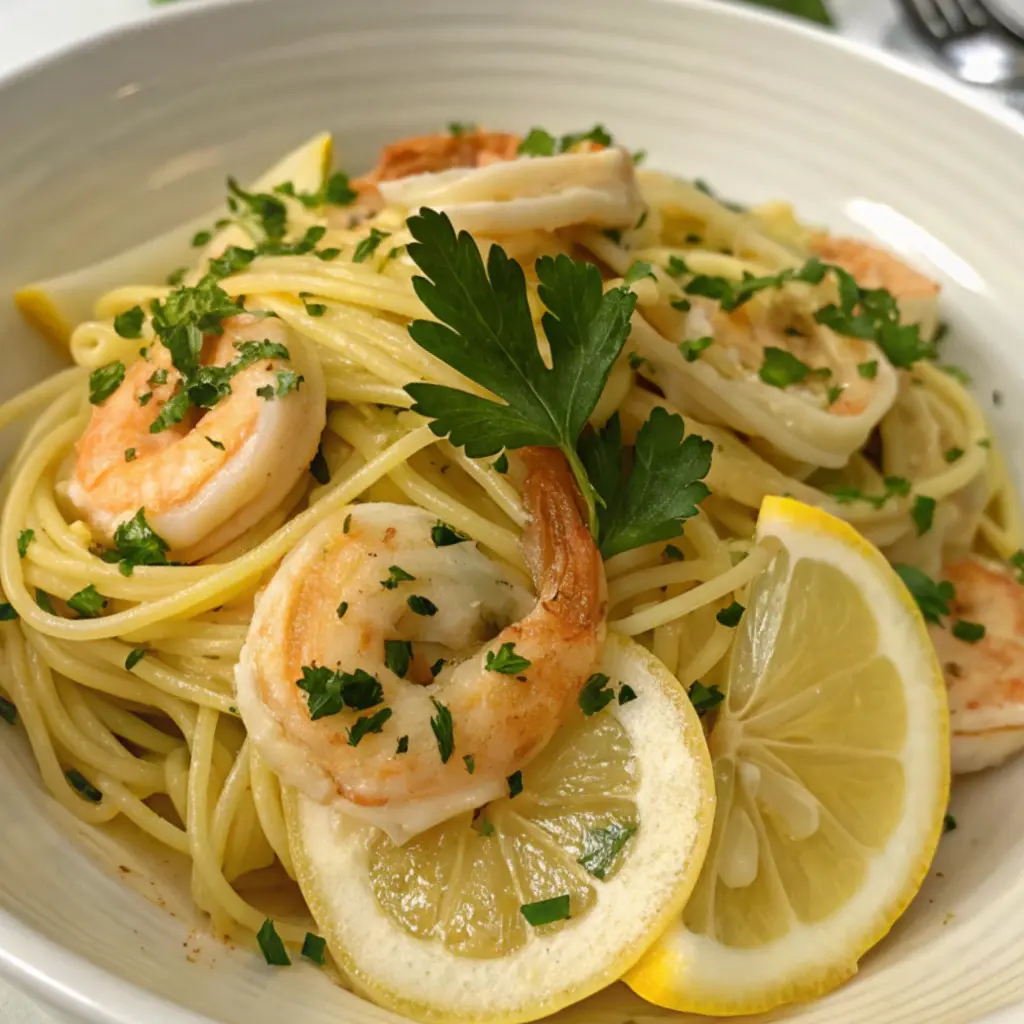I first made this lemon shrimp pasta on a Wednesday that felt heavier than most. The kids had been cranky, the dishwasher was broken, and I had precisely twenty-seven minutes to pull something—anything—together for dinner before everyone’s patience (mine included) unraveled completely. I remember opening the fridge, seeing a forgotten bag of frozen shrimp and half a lemon in the crisper, and thinking, “Well, let’s see what we can make of this.” What came out of that chaotic evening was something unexpectedly lovely—a silky, lemon-scented pasta twirled with tender shrimp, garlic, and just enough butter to feel like a small indulgence. It tasted bright and comforting all at once. I’ve made it countless times since, refining it slightly with each batch, but that first meal set the tone: unfussy, flavorful, and just what we needed. It’s the kind of dish that reminds me why I cook—not just to feed, but to nurture and restore. I hope it does the same for you.

Why You’ll Love This Recipe:
- Quick enough for a weeknight, elegant enough for company
- Light and zesty, but still satisfying
- Uses mostly pantry staples
- Easy to adapt to what you have on hand
- Comes together in under 30 minutes
Ingredients You’ll Need:
- Pasta: I usually reach for linguine or spaghetti, but truly, any long noodle works. I’ve made this with fettuccine, bucatini, and even tagliatelle once when that’s all I had. It all works.
- Shrimp: I use peeled and deveined medium shrimp, usually from the freezer. Just be sure to pat them dry before cooking so they sear, not steam. Tail-on looks pretty if you’re serving guests, but I take them off at home for easier eating.
- Garlic: Fresh is best here. You’ll want it thinly sliced or minced so it infuses the butter and oil gently.
- Lemon: Zest and juice both. The zest gives brightness without too much acidity, while the juice sharpens the whole dish.
- Olive Oil & Butter: The combination gives you flavor and richness without being too heavy. I start with oil to sauté, then swirl in butter at the end to finish the sauce.
- Red Pepper Flakes: Optional, but I love the gentle warmth it brings. Adjust to your liking.
- White Wine (or Broth): A splash deglazes the pan and adds depth. Don’t worry if you don’t have wine—chicken broth or even reserved pasta water will do.
- Parsley: Fresh and chopped. It’s not just garnish—it adds color and a touch of earthiness that balances the lemon beautifully.
- Parmesan (optional): Controversial with seafood, I know. But a light dusting over the top? Yes, I’ve done it, and yes, it’s delicious.
How to Make It (Step-by-Step Instructions):
Start by bringing a big pot of salted water to a boil. Give it a generous handful of salt—it should taste like the sea, as they say. While that’s heating up, set a large skillet over medium heat and add your olive oil. Once it shimmers, toss in your shrimp in a single layer. Let them sizzle undisturbed for about a minute or two, just until they start turning pink around the edges. Flip them, cook another minute, then scoop them out and set aside. Don’t overcook them here—they’ll finish in the sauce later.
In the same skillet, add a bit more oil if needed and toss in your garlic. Let it go gently—no rushing here. If it starts to brown too quickly, pull the pan off the heat and swirl. You’re after that mellow garlic perfume, not bitterness. If you’re using red pepper flakes, add them now so they bloom in the oil.
Pour in your splash of white wine or broth, scraping up the bits on the bottom. Let it bubble for a minute or two—enough to reduce just slightly. This is where the flavor starts to layer. While that’s happening, your pasta should be boiling. Cook it until just shy of al dente, because it’ll finish in the skillet.
Reserve a mugful of pasta water before draining—trust me, you’ll want it.
Add your drained pasta straight into the skillet. Then in go the shrimp, lemon zest, lemon juice, and a knob of butter. Toss everything together with tongs, adding pasta water a little at a time until the sauce clings just right—silky, not soupy. Finish with fresh parsley, and if it feels right, a touch of Parmesan.
Taste. Adjust. Maybe another squeeze of lemon, maybe a pinch of salt. Serve warm, with good bread if you’ve got it, and a glass of whatever wine you used in the sauce.

Expert Tips for the Best Results:
One thing I’ve learned over time is to give each component its moment. Don’t rush the shrimp—they’re quick, but they still need space in the pan. Let the garlic go gently, or it’ll turn harsh. And don’t be afraid to use that pasta water—it’s liquid gold for pulling everything together. Also, zest your lemon before you cut it—ask me how many times I’ve forgotten and tried zesting a juiced half. The sauce should feel light and glossy, not greasy or watery, and that balance comes from tasting as you go. It’s a simple dish, but one that rewards attention to detail.
Variations & Substitutions:
This dish is forgiving in the best way. I’ve swapped the shrimp for scallops once—delicious. I’ve used spinach when I didn’t have parsley, and it added a nice bit of body and color. One time, I had no wine and no broth, so I used a splash of the pasta water early and leaned into the lemon more—it worked just fine. If you’re dairy-free, leave out the butter and just finish with olive oil. Want it creamier? A splash of cream or a dollop of mascarpone at the end transforms it into something luxurious. Don’t be afraid to make it your own.
Serving Suggestions:
This pasta’s lovely on its own, but I often serve it with a simple green salad—something with a bite, like arugula or endive, dressed with lemon and olive oil. A loaf of crusty bread is ideal for swiping the pan clean. It also makes a wonderful dish for company—I’ve brought it to the table on summer evenings, served with cold white wine and good conversation. But it’s just as satisfying eaten out of a warm bowl on the couch after a long day. It fits both moods.
Storage & Reheating Instructions:
Leftovers keep surprisingly well. I let the pasta cool completely, then store it in an airtight container in the fridge for up to two days. When reheating, I splash in a little water or broth and warm it gently on the stove or in the microwave, tossing halfway through. The shrimp won’t be quite as tender the second time, but the flavors mellow and deepen in a lovely way. I’ve even eaten it cold from the fridge—no regrets.
Recipe FAQs (Answered by Clara):
Can I use frozen shrimp?
Absolutely. Just make sure they’re thawed and patted dry before cooking, so they get that nice sear instead of steaming.
What kind of pasta works best?
Linguine or spaghetti are my favorites, but anything long and twirlable does the trick. I’ve even used angel hair in a pinch—just watch the cook time.
Is this spicy?
Only if you want it to be. I add a pinch of red pepper flakes, but it’s easy to leave out if you’re cooking for little ones or prefer a milder flavor.
Can I make this ahead of time?
Yes. I often make the sauce components ahead, then just boil the pasta and combine everything at dinnertime. It comes together in minutes.
Does Parmesan really go with shrimp?
I know it’s debated, but I say if it tastes good to you, go for it. I don’t use much, just a whisper over the top sometimes.

There’s something so comforting about a dish that feels both special and simple—that’s what this lemon shrimp pasta has become for me. It’s saved more dinners than I can count and still manages to surprise me with how good it is, every time. If you give it a try, I’d love to hear how it turned out—what you added, what you skipped, or who you shared it with. Recipes like this live in the little variations we bring to them. Thanks for cooking with me—see you back here soon.
Nutrition Information (Approximate, per serving):
Calories: 410 | Protein: 26g | Carbohydrates: 42g | Fat: 15g | Fiber: 2g | Sodium: 480mg


Leave a Reply